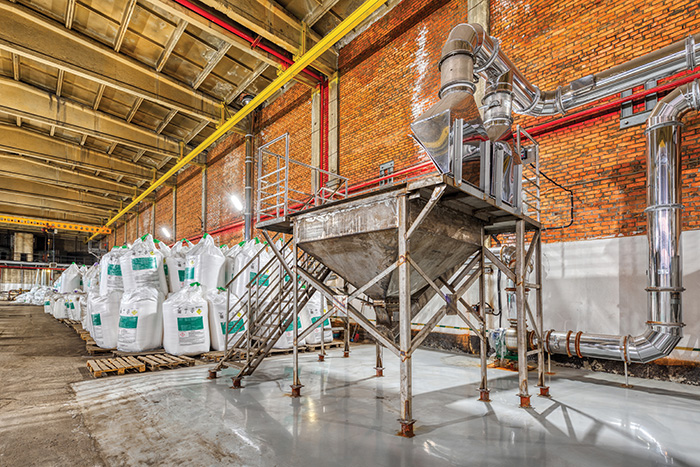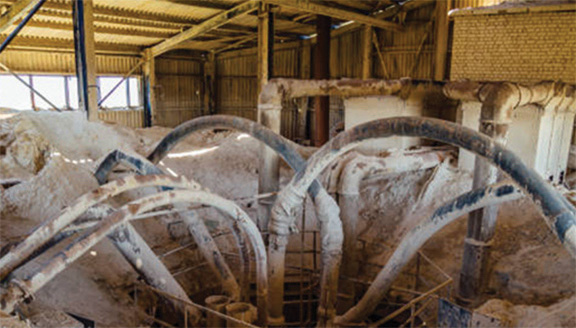By carefully considering equipment and plant design in processes involving powdered materials, fugitive dust issues can be reduced significantly
Powdered ingredients that unintentionally leak from equipment in a manufacturing plant are known as fugitive dust. The risks associated with fugitive dust are very real. The three major risk factors are: 1) combustion risk 2) operator exposure (inhalation and contact) risk and 3) product hygiene risk. It is difficult, if not impossible, to eliminate all dust from a manufacturing plant, but controlling fugitive dust starts with equipment design. Minimizing dust in and around bulk-material-handling systems is most effective when less dust is allowed to escape from your material-handling system. This article provides information on design strategies and considerations for building effective dust containment into new equipment. This approach may increase upfront equipment cost, but will lower operating costs and avoid dust-issue headaches later.
Dust reduction by design
The importance of plant housekeeping should not be overlooked in controlling dust, but there is more to it. Automated powder-handling systems are made up of multiple components, working in concert, to move ingredients from storage containers to processing equipment. Features to control fugitive dust can be designed into each component that make up the system. These components include conveying, filtering, dosing, loading and unloading. An initial focus on these components, followed by the entire ingredient-handling system, can go a long way toward reducing fugitive dust and lost material. For example, integrated designs have self-cleaning filters that return collected dust back into the production process. In contrast, centralized dust control systems collect dust in a central baghouse. This dust is lost from production, because it becomes contaminated with all the other dust in the collection point. Centralized dust control is effective for containing fugitive dust, but has higher operating costs due to this lost material. Fugitive dust control is no easy feat since the whole is only as good as the sum of each component in a material handling system (Figure 1).

Figure 1. All components of the solids-handling system, from bulk bags, like those shown here, to feeding and conveying, should be considered in a dust-mitigation strategy
Combustion risk
Most powdered material has some combustion threat, so each ingredient in your plant should be identified and analyzed for material-specific risks (Figure 2). Combustion requires three elements: heat, fuel and oxygen. Airborne dust significantly increases the combustion risk of any powder because this dust cloud already includes two sides of the fire triangle, fuel and oxygen. Only heat, or specifically, an ignition source, is needed for dust combustion.

Figure 2. Fugitive dust can lead to explosions, so each material should be analyzed for combustion risk, and materials-handling processes should be examined for the root cause of the dust escape
Many common ingredients pose significant combustion threats. Sugar provides an illustrative example. There have been many high-profile industrial accidents, involving sugar, attributable to poor material-handling practices. One noteworthy event was the destruction of Imperial Sugar’s refinery in Savannah (Port Wentworth), Georgia in 2008. This accident started with a relatively small sugar dust explosion, which triggered a chain reaction of explosions and shock waves, each causing more fugitive dust to become airborne and feed the chain reaction. The resulting fire killed 11 employees and took an entire week for firefighters to extinguish.
Each powder has its own properties and characteristics. A dust hazards analysis (DHA) in accordance with National Fire Protection Association (NFPA; Quincy, Mass.; www.nfpa.org) standards is a good way to identify potential risks around your factory. NFPA is an international nonprofit organization devoted to eliminating death, injury, property and economic loss due to fire, electrical and related hazards. Focus on DHAs has increased lately due to several pending compliance deadlines. While not an enforcement agency, the NFPA has set two specific testing deadlines. The first deadline, which applies to compliance with NFPA 652 industries (which include: chemical, food, fertilizer, tobacco, plastics, rubber, pesticides, pharmaceuticals, rubber, wood, dyes and metals) was September 7, 2020. The second deadline applies to NFPA 61 (industries doing primarily agricultural processing) has a deadline of January 1, 2022. The authors encourage all manufacturers to be aware of their resident dust hazards and to take appropriate safety precautions to protect both people and property.
Component design tips
Once material challenges are identified, a plan of action should be developed to mitigate the risks associated with fugitive dust. A review of known problem areas often leads to a classic management decision — replace or repair. While capital budgets are always tight, trying to repair worn out or poorly designed equipment often treats the fugitive dust symptoms rather than the root cause. Other factors to consider in deciding to replace or repair equipment include capacity constraints, the amount of manual labor required and the age of the control system. If capital budgets allows for replacement, then new equipment design becomes critical.
As stated at the outset, good dust control starts with equipment design, but the entire system design as a whole should also be considered. Bulk powder material-handling systems usually involve multiple ingredients moving through a series of single-function components that operate together in a fully integrated system. The following provides design tips to control fugitive dust in components commonly found in material-handling systems, including conveying, filters, feeders, bulk unloaders and bag dumps, as well as considerations for integrated system design and plant layout.
Conveying. There are two basic ways to use air to move powdered material through pipes — pressure and vacuum conveying. Pressure conveying uses air at a higher pressure than ambient pressure, to “blow” powders through pipes. Vacuum conveying uses air at a lower pressure than ambient pressure, to “suck” powders through pipes. Both technologies have their place in the material-handling world, but vacuum systems have some particular benefits with regard to fugitive dust control. Since vacuum conveying operates under negative pressure, leaks in the conveying line will draw air into the conveying system. While such a leak is an operating inefficiency, ingredient dust remains in the system and does not create fugitive dust. A leak in a pressurized conveying system does the opposite; conveying air will be blown out of the conveying system, and with it, fugitive dust. Leaks in pressure-conveying systems can create extremely dusty work environments if not corrected. For this reason, vacuum conveying is inherently a cleaner way to move bulk powders as compared to pressure conveying.
Material conveying systems moving ingredients often have long conveying distances, sometimes through inaccessible areas. This can make leak detection a tedious and time-consuming exercise with pressure-conveying systems. Leaks can be easily missed if they are located in a hard-to-reach areas or hidden behind other equipment. This is of special concern when conveying toxic or noxious materials. Products that could be harmful to operators are best conveyed by vacuum systems, because leaks do not create fugitive dust.
Filters. Filters play a critical role in material-handling systems and are critical for effective dust control. Filters are used to separate ingredient dust from conveying air exiting the system. Filters are a critical safety component to control dust emissions from bulk-material-handling equipment. Commonly located at the receiving hopper at the end of a conveying line, filters have several functions: cleaning the conveyed air, preventing overpressuring the hopper, and recycling the ingredient dust that was suspended in the air flow. The filter strips dust out of the conveying air so it can be vented into the plant or to the environment through an exterior opening. Regular preventive maintenance of the filters keeps the filters working and promotes good plant housekeeping.
Integrated filters are installed in the receiving hopper and include self-cleaning features to reduce filter maintenance and lost material. One self-cleaning filter mechanism uses pressurized air to pulse the filter media, causing dust on the dirty side of the filter to loosen and fall down to join the rest of the ingredients in the hopper. This process not only cleans the filter, it also minimizes ingredient loss. Filters installed outside of the receiving hopper and connected to a centralized dust collection perform the same cleaning function, but cannot recycle product dust.
Filter cleaning and change-out frequency is product-specific, but critical nonetheless. Dust accumulation on the filter limits the effective filter surface area and ultimately clogs the filter media. Self-cleaning filters will extend filter life, but frequent inspection should still be performed to ensure there are no tears or splits in the filter. Particle size also affects the frequency of bag changes. There is wide variety of filter media and open area available to meet any manufacturing specification. Most filters are made of polyester, but there are other materials and filter features available. Anti-static filters reduce static electricity created by filter pulse cleaning. A PTFE (polytetrafluoroethylene) filter is more effective because it has a higher micron-retention rate. PTFE filters are also very effective when dealing with sticky material as its PTFE coating allows built up material to slide off more easily than common polyester filters.
Dosing. Dosing, also known as feeding, is the means by which consistent streams of ingredients are introduced into a process at a certain rate. Whether dosing into an extruder, a conveying line or loss-in-weight/gain-in-weight feeders, there are many concerns related to measuring accuracy, but there are also dust leakage issues to be aware of. Dust does not generally accumulate in the feeder itself; the real dust issues are further downstream where the material is discharged from the feeder. If the feeder discharges into a dust-tight closed container, then this risk is easily mitigated. Many feeders, however, feed into open hoppers or scales. In this case, a connection to a dust-control system is highly recommended. In most cases, this would be a centralized dust-control system.
A secondary concern to avoid excessive dust around feeders is making sure they are properly sealed. A feeder is a closed-component, so visible dust generally indicates a worn seal. There are three areas in a feeder that require regular seal inspection. These areas are the inlet flange, the main drive and the discharge. If you spot dust around a feeder, chances are there is a bad seal in one of these locations. Regularly scheduled preventive maintenance for these seals in the feeder is recommended. If one of the seals is found to be worn, replacing all the seals and gaskets at the same time is likely the best course of action. It costs a little more, but the rebuilt feeder operates like new and will ensure trouble-free performance when put back in production.
Bulk-bag unloading. Bulk-bag unloading involves emptying big bags, super sacks, bulk bags (all describe a 2,000-lb cloth sack) as efficiently and cleanly as possible (Figure 1). Bulk bag unloaders are common in all industries and just about every manufacturing plant has at least one. Generally, bulk-bag unloading is very dusty, but it doesn’t have to be. Fugitive dust can be released from two different sources: poor equipment design and operator errors. Let’s start with design first. There is a wide choice of bulk bag unloaders on the market and generally you get what you pay for. Higher-price bulk-bag unloaders usually include better dust management features. Such features include: active dust control when connecting or disconnecting bags; empty bag dust control; bag connections that are dust-tight; and outlet spout control.
With these dust-control features in mind, there are four basic actions to control fugitive dust when unloading bulk bags. First, each full big bag should be properly connected to the unloading mechanism. The bag connection should be tight, properly sealed and user friendly (no hand tools required). Second, the connection should be made in a closed hopper that has its own, built-in dust-control system. As the product begins to flow from the bag into the hopper, the air displaced from the hopper should be vented to a dust-control system. Lastly, the empty bag should be collapsed while in the frame and still attached to the dust-control system. An empty big bag usually has residual dust in it and is often the primary source of dust around big bag unloaders.
A bulk bag unloader’s bag connection is particularly effective if it includes a cover. This connection unit is sometimes referred to as a big bag adapter (BBA). With a cover, the BBA can be sealed once a full bag is connected or an empty bag disconnected. The flow of product out of the big bag will create a rush of displaced air out of the hopper. This displaced air includes a lot of dust and needs to be contained inside the hopper. A vent stub, built into the hopper, is the most effective way to prevent fugitive dust from escaping the unloader. The same vent is also used to capture residual dust before disconnecting an empty big bag.
Operator errors can also generate a lot of fugitive dust around big bag unloaders. Operators should be regularly trained and monitored to ensure they follow procedures and use the dust control features built into the big bag unloaders. Care should also be taken by operators as they remove empty bulk bags from the big bag unloader. Not all materials flow freely from big bags and a significant amount of dust can be retained in the fabric folds of an empty bag. To control this residual dust, the bag must be deflated while connected to the BBA and its dust-control system. The operator should also manually flex the bag and spout before disconnecting the bag. The empty bag is now ready to be removed from the big bag hoist and transported away from the work area. Skilled operators that follow proper procedures can significantly reduce the release of fugitive dust.
As a last point to mention about big bags, don’t overlook fugitive dust created by tears or rips in fabric big bags caused by careless handling and storage. Careless fork truck drivers can easily rip or tear super sacks when moving them from the warehouse to the big bag unloading station. Big bags can be ripped by brushing against sharp edges or punctured by lift truck forks. Access to big bag unloader stations should be considered in plant layouts to minimize super sack damage.
Bag dumps. Bag dumps are used to manually unload raw materials stored in cloth or paper sacks, normally between 50 and 100 pounds. This dumping process has dust-control issues similar to those of big-bag unloading mentioned earlier. The operator must cut the sacks open and dump the contents into the bag dump. There are two types of bag dumps: dedicated bag dumps (for storage) and pass-through receivers (for conveying). This cutting and dumping process can generate a lot of dust, exposing the operator and work environment to fugitive dust. This dust can be controlled by either an integrated dust collector, which is built into each bag dump, or a centralized dust collector, where the bag dump is connected to a common dust-collection system.
As mentioned previously, an integrated dust collector, built into the bag dump, has the advantage of recycling the dust back into the hopper; all the dust that it is collected in the hopper stays with the product. A common dust-control system will control dust, but will lose material to production. Either dust-control system should be automatically activated when the bag dump door is opened by the operator. That way, the operator does not have to remember to turn on the dust-control system. When the door is opened, the fan activates and draws air into the hopper from around the operator. As the operator dumps bags, the product dust is drawn away from the operator into the hopper. With an integrated dust control system, closing the bag-dump door automatically pulses the filter with a blast of air, which releases captured dust on the filter and drops it into the hopper.
Lastly, be sure to include a plan to deal with the empty bags. These bags, while empty, are usually full of residual dust. Improper bag disposal can produce a giant cloud of fugitive dust, covering both the operator and the work area. Look for bag dumps that include bag-disposal systems that accumulate empty bags into a sealed trash bag without releasing fugitive dust. While costlier, this feature will pay for itself many times over.
Flex sleeves. A flex sleeve is a flexible section of plastic conduit often used in conveying lines that aids the flow of product through the conveying system. The flexible conduit is especially effective when dealing with materials that are sticky, pack easily or have a high fat content. The flex sleeve is connected to the metal conveying lines with a pipe clamp at each end of the sleeve. The sleeve’s flexibility allows it to vibrate and move, helping to dislodge built up product inside the flex sleeve. This movement, while effective for dislodging material, requires regular maintenance to ensure the clamp connections remain tight and dust-free. This is especially important for pressurized-conveying systems. Plant maintenance should also check flex sleeves for rips or tears, because constant movement will fatigue the plastic sleeve. Flex sleeves should only be installed in areas that are both visible and accessible.
Controlling fugitive dust is challenging, but equipment designed with integrated dust-control features can give operators the tools they need to do their jobs safely and cleanly.
Edited by Scott Jenkins
Authors
 Chuck Kerwin is the general manager of AZO Inc., (4445 Malone Rd., Memphis, TN 38118; Phone: (901) 794-9480; Email: [email protected]), the wholly owned U.S. subsidiary of Germany-based AZO GmbH, a leading supplier worldwide of automated powder-material-handling systems. AZO Inc. provides sales, project management and service support for AZO’s customers in the U.S. and Canada. Kerwin has been with AZO for over 20 years as both general manager and controller. He graduated from the Georgia Institute of Technology (Georgia Tech) with a bachelor’s degree in civil engineering, and also earned an MBA from Georgia State University. Kerwin resides in Memphis, Tenn. with his wife Tricia.
Chuck Kerwin is the general manager of AZO Inc., (4445 Malone Rd., Memphis, TN 38118; Phone: (901) 794-9480; Email: [email protected]), the wholly owned U.S. subsidiary of Germany-based AZO GmbH, a leading supplier worldwide of automated powder-material-handling systems. AZO Inc. provides sales, project management and service support for AZO’s customers in the U.S. and Canada. Kerwin has been with AZO for over 20 years as both general manager and controller. He graduated from the Georgia Institute of Technology (Georgia Tech) with a bachelor’s degree in civil engineering, and also earned an MBA from Georgia State University. Kerwin resides in Memphis, Tenn. with his wife Tricia.
 Gus Carrington is a communications specialist for Memphis, Tenn.-based AZO Inc. (same address as above; Email: [email protected]). He studied strategic media at the University of Memphis, where he led a team of award-winning reporters at The Daily Helmsman.
Gus Carrington is a communications specialist for Memphis, Tenn.-based AZO Inc. (same address as above; Email: [email protected]). He studied strategic media at the University of Memphis, where he led a team of award-winning reporters at The Daily Helmsman.